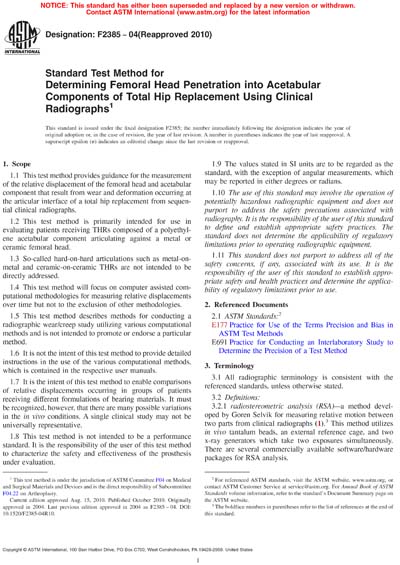Historical
ASTM F2385-04(2010)
Standard Test Method for Determining Femoral Head Penetration into Acetabular Components of Total Hip Replacement Using Clinical Radiographs
1.1 This test method provides guidance for the measurement of the relative displacement of the femoral head and acetabular component that result from wear and deformation occurring at the articular interface of a total hip replacement from sequential clinical radiographs.
1.2 This test method is primarily intended for use in evaluating patients receiving THRs composed of a polyethylene acetabular component articulating against a metal or ceramic femoral head.
1.3 So-called hard-on-hard articulations such as metal-on-metal and ceramic-on-ceramic THRs are not intended to be directly addressed.
1.4 This test method will focus on computer assisted computational methodologies for measuring relative displacements over time but not to the exclusion of other methodologies.
1.5 This test method describes methods for conducting a radiographic wear/creep study utilizing various computational methods and is not intended to promote or endorse a particular method.
1.6 It is not the intent of this test method to provide detailed instructions in the use of the various computational methods, which is contained in the respective user manuals.
1.7 It is the intent of this test method to enable comparisons of relative displacements occurring in groups of patients receiving different formulations of bearing materials. It must be recognized, however, that there are many possible variations in the in vivo conditions. A single clinical study may not be universally representative.
1.8 This test method is not intended to be a performance standard. It is the responsibility of the user of this test method to characterize the safety and effectiveness of the prosthesis under evaluation.
1.9 The values stated in SI units are to be regarded as the standard, with the exception of angular measurements, which may be reported in either degrees or radians.
1.10 The use of this standard may involve the operation of potentially hazardous radiographic equipment and does not purport to address the safety precautions associated with radiography. It is the responsibility of the user of this standard to define and establish appropriate safety practices. The standard does not determine the applicability of regulatory limitations prior to operating radiographic equipment.
1.11 This standard does not purport to address all of the safety concerns, if any, associated with its use. It is the responsibility of the user of this standard to establish appropriate safety and health practices and determine the applicability of regulatory limitations prior to use.
Content Provider
ASTM International [astm]






